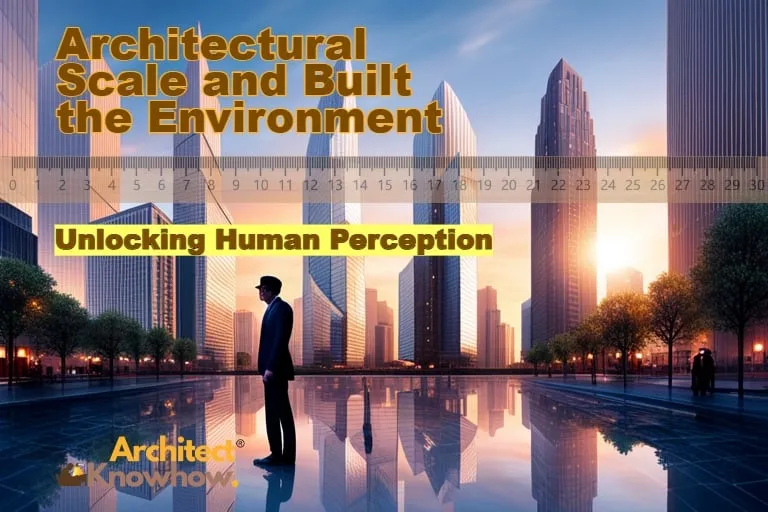The Built Environment, Scale, and Human Perception | Architect Knowhow
The Symphony of Scale: Understanding the Built Environment and Human Perception.

Navigating our world, our sight acts as a natural GPS system. Our eyes immediately survey the surroundings, making subconscious judgments and understanding the space. We create perceptions based on our origins, familiarity, and past subconscious associations. This intrinsic human ability is deeply intertwined with the complex world of architecture and urban planning.
Ever walked into a room and immediately felt its coziness or sensed the vastness of space? The harmonious marriage of scale and architecture has unknowingly influenced you. Let's explore a little deeper into the intricate relationship between the built environment, scale, and our human perception.
Sight Over Touch: How We Perceive Our World
Primarily, we humans have always been visual creatures. We discern the ambiance of a room through our eyes, relying on familiarity and previous subconscious associations. Think of it as reading a room without even knowing you're doing it.
This perception by sight plays a pivotal role when understanding architectural spaces based on two key factors:
- The size of the space in relation to our body: Is it making you feel cozy or lost?
- The size of architectural elements and the weight they add to a space: Picture standing in a serene courtyard versus feeling minuscule beneath a massive skyscraper.
Imagine standing in a quaint courtyard and then juxtaposing that with the overwhelming feeling of being beneath a towering skyscraper. It's quite a contrast, right?
In architectural dialogue, the concept of scale touches upon the spatial dimensions relative to human proportions and the balance of architectural components within that space. Whether it's the intimate setting of a compact atrium or the expanse of an exhibition hall, our body instinctively reacts to it.
The Vertical Scale: Our In-Built Altitude Meter
While many dimensions dictate a space, the height or vertical scale takes the limelight. It’s fascinating how our eyes are like built-in altitude meters, sensing changes in height more rapidly than alterations in the plan layout or organization.
Our eyes are more than just sensory organs. They capture light, focus it, and, in collaboration with the brain, shape our perception of depth, colour, movement, and so much more. This dynamic partnership enables us to appreciate the nuanced details of architecture and helps in the precise tasks we undertake daily.
This eye-brain coordination not only helps us navigate spaces but also deepens our appreciation of the architectural wonders surrounding us.
The Built Environment: An Architectural Symphony
The built environment is the world we've sculpted – Defining the 'built environment' is like describing the stage of life. Be it our favourite nook at home or the extensive industrial and commercial zones we traverse daily. It is where life for us as human beings plays out.
This environment is an ensemble of architectural elements, spaces, and scales that range from humble beginnings to sprawling cities. It’s a blend of our residences, workspaces, and recreation zones. Each structure, each nook, and corner, contribute to the orchestration of this vast symphony we often refer to as our environment.
What it is then that gives it a distinctive touch? The buildings, their function, arrangement, and the choice of materials, each contribute uniquely to this grand symphony. As architects, our choice of materials and designs lends a unique note, creating a melody that resonates with those who inhabit these spaces.
These architectural marvels do more than just meet the eye. They shape our understanding, experiences, and appreciation of aesthetics. Especially for those embarking on a career in architecture, recognising the impact of each design choice is pivotal. From grand masterplan layouts to the finer details of materials, every design decision plays a role in shaping a space's ambiance and function.
Scale and Relativity: The Heart of Design
Our reactions to spaces are deeply personal. Whether you're a nature lover enchanted by expansive landscapes, or a city dweller enthralled by skyscrapers, the underlying thread is scale. Our understanding of a place often boils down to its relative size and how we relate to it.
There might be times when we're torn away from our familiar settings, but it's imperative to understand that unfamiliar terrains, whether a tranquil countryside or a bustling city center, hold their charm. It's the scale that acts as the tether, grounding our sense of belonging.
A design that aligns with human norms can be said to be 'in scale'. However, scale's influence stretches beyond individual structures; it dictates how buildings and other constructions communicate with one another. When scales are vastly different, the result can be visually unsettling. The goal, then, isn’t to create a fixed standard, but rather to weave a harmonious relationship, creating a visually satisfying experience.
While architectural design aligns with human norms, the scale can either be "large" or "small". This measure often decides the harmony of spaces and their interaction.
To quote Reekie from 1972, scale isn't confined to a single structure. It's about how buildings interplay, ensuring a visual coherence that's pleasant and harmonious.
Scale, therefore, isn't merely an architectural term. It's an integral aspect of how we perceive, interact with, and appreciate our surroundings. Just like Goldilocks, finding the "just right" balance is the key. As architects, it is incumbent upon us to explain that in our design solutions.
For those probing deeper into architectural dialogue, and discovering that architectural design solution, my book ‘Planning Permission Expertise for Building and Extensions: Book One – How to get Started’ touches upon the criticality of understanding the built environment. Book Two – Site Research to Planning Decision takes you to the next level of architectural thinking, especially when preparing a planning submission.
For now, as you move through your day, take a moment to appreciate the architectural wonders around you. Until next time, stay curious and inspired!




